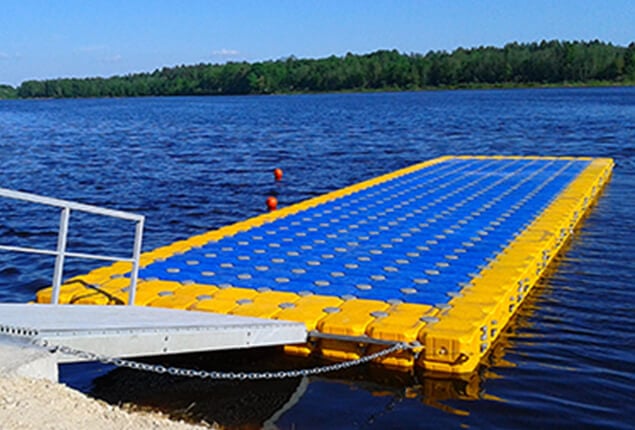Locate the Perfect Floating Dock Builder to Bring Your Waterside Vision to Life
Produce the Perfect Docking Service With Floating Docks
Floating docks existing a functional remedy for a variety of maritime needs, adapting effortlessly to rising and fall water levels and varied vessel types. As we explore the necessary aspects that add to the efficiency of floating docks, numerous essential elements concerning stability and upkeep will emerge, elevating concerns about exactly how to optimize your docking experience.

Advantages of Floating Docks
Floating docks offer various advantages that make them a suitable selection for numerous maritime applications. Among the main benefits is their versatility to altering water levels. Unlike dealt with docks, floating docks fluctuate with the trend, ensuring regular ease of access for vessels. This function is especially crucial in areas prone to significant tidal fluctuations or seasonal water degree adjustments.
Additionally, floating docks are generally easier and quicker to install contrasted to conventional fixed frameworks. Their modular style allows for uncomplicated setting up and disassembly, helping with upkeep and moving when required. This adaptability is specifically useful for short-term applications or in environments where problems may transform.
Floating docks also tend to be extra ecologically friendly, as they lessen disruption to the seabed and bordering marine communities. Their buoyant nature minimizes the danger of damages to marine life, advertising a healthier setting. Additionally, these docks can be personalized to fit various vessel dimensions, ensuring that they meet certain functional needs - floating dock services.
Inevitably, the combination of adaptability, simplicity of installment, and ecological factors to consider makes floating docks an extremely effective solution for a wide variety of maritime demands.
Picking the Right Products
Selecting the proper products for floating docks is important to make certain toughness, security, and long life. The choice of materials directly impacts the dock's performance in various environmental conditions, including exposure to water, sunshine, and possible wear from aquatic website traffic.
Usual products utilized for floating docks include aluminum, timber, and high-density polyethylene (HDPE) Light weight aluminum is light-weight, corrosion-resistant, and needs very little maintenance, making it an outstanding choice for longevity. However, its first price can be greater compared to other materials.
Wood, while aesthetically appealing and providing a traditional appearance, can be at risk to rot and bug damage otherwise effectively dealt with. Making use of pressure-treated timber or normally durable varieties like cedar or redwood can mitigate these issues.
HDPE is a preferred selection as a result of its resistance to UV rays and chemicals, together with being eco-friendly. floating docks. It is readily available and light-weight in various shades, enabling modification
Eventually, the right product choice will certainly depend on certain requirements, including spending plan, desired visual appeals, and ecological considerations. Cautious analysis of these elements will certainly lead to a effective and resistant floating dock remedy.
Layout Factors To Consider for Stability
When creating floating docks, making certain security is a fundamental facet that can substantially influence their capability and safety and security. Stability in floating dock style is affected by different factors, including buoyancy, weight circulation, and the arrangement of components.
Weight distribution is critical; uniformly distributing tons throughout the dock protects against tilting and improves stability. This can be accomplished with critical placement of docking tools, such as cleats and fenders, in addition to appropriate spacing of drifts. In addition, the measurements of the dock ought to be attentively planned. Wider layouts can supply enhanced stability, especially in harsh water conditions, while longer docks may require additional supports to stop drooping.
One more crucial consideration is the environmental effect, including wave activity and wind. Including attributes such as sidewalls or skirting can aid mitigate the results of ecological forces, keeping stability in negative problems. Eventually, a combination of thoughtful style, material option, and understanding of environmental elements will certainly yield a floating dock that satisfies both stability and security demands.
Setup Tips and Techniques

Next, protect the needed permits and comply with regional regulations, which might determine setup techniques and environmental considerations. Engage a certified service provider experienced in floating dock setups if needed. Usage top notch materials designed for marine settings to enhance resilience and longevity.
When positioning the dock, align it alongside the shoreline to help with simple access. Guarantee that the anchoring system is robust, utilizing cinder block or helical anchors to stabilize the dock against wind and wave action. It's essential to make up seasonal water degree variations, consisting of potential ice activity in colder environments.
Throughout the installment, confirm the dock's floatation and security before wrapping up the anchoring. On a regular basis inspect the installation for any kind of indicators of wear or damage. By adhering to these methods and suggestions, you can attain a protected, practical, and visually pleasing floating dock installation that fulfills your requirements.
Upkeep and Treatment Standards
Caring and keeping for floating docks is critical to extending their life expectancy and ensuring secure use. Normal inspections must be performed to identify any indicators of wear, damages, or Continued aquatic growth. Look for splits, loose fittings, or stained areas on the dock's surface area, as these problems can compromise structural integrity.
Cleaning up is crucial. Make use content of a pressure washing machine to get rid of algae, barnacles, and particles, which can build up gradually. For persistent growth, think about eco-friendly cleaner that will not harm aquatic life.
In addition, examine the mooring lines and anchors frequently to guarantee they are complimentary and secure from rust. Change any type of torn or damaged lines without delay to maintain stability.
During severe weather, such as tornados or freezing conditions, take preventive steps. Protect the dock with additional mooring lines and, if practical, remove any removable parts to avoid damages.
Conclusion
To conclude, the application of floating docks offers a versatile and reliable docking option ideal for various maritime applications. Their versatility to varying water levels, incorporated with a modular layout, enables easy modification and relocation. Selecting proper materials boosts both resilience and aesthetic charm, while cautious factor to consider of stability ensures security and longevity. With appropriate installation and routine upkeep, floating docks can offer trustworthy and effective docking experiences for a wide variety of vessels.
As we explore the crucial components that contribute to the efficiency of floating docks, several essential variables regarding stability and maintenance will arise, elevating questions floating dock company regarding just how to maximize your docking experience. Unlike fixed docks, floating docks rise and autumn with the trend, making sure regular accessibility for vessels.When developing floating docks, making sure security is a basic facet that can considerably impact their performance and security. Stability in floating dock style is influenced by various elements, including buoyancy, weight distribution, and the arrangement of components. Eventually, a mix of thoughtful style, material option, and understanding of environmental factors will yield a drifting dock that fulfills both security and safety and security needs.